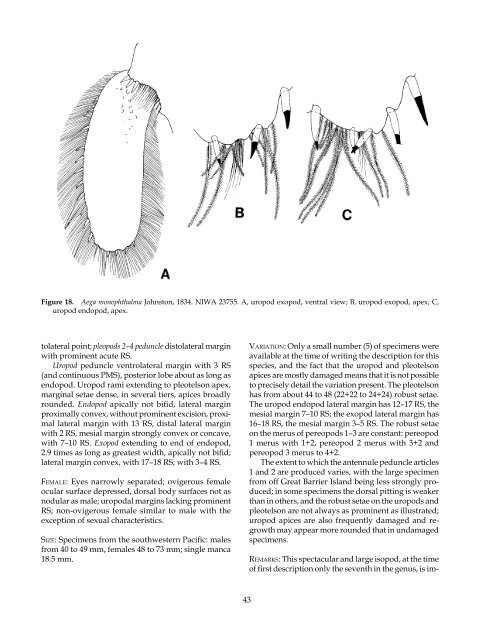The Marine Fauna of New Zealand: Isopoda, Aegidae (Crustacea)
The Marine Fauna of New Zealand: Isopoda, Aegidae (Crustacea)
The Marine Fauna of New Zealand: Isopoda, Aegidae (Crustacea)
Create successful ePaper yourself
Turn your PDF publications into a flip-book with our unique Google optimized e-Paper software.
Figure 18. Aega monophthalma Johnston, 834. NIWA 23755. A, uropod exopod, ventral view; B, uropod exopod, apex; C,<br />
uropod endopod, apex.<br />
tolateral point; pleopods 2–4 peduncle distolateral margin<br />
with prominent acute RS.<br />
Uropod peduncle ventrolateral margin with 3 RS<br />
(and continuous PMS), posterior lobe about as long as<br />
endopod. Uropod rami extending to pleotelson apex,<br />
marginal setae dense, in several tiers, apices broadly<br />
rounded. Endopod apically not bifid, lateral margin<br />
proximally convex, without prominent excision, proximal<br />
lateral margin with 3 RS, distal lateral margin<br />
with 2 RS, mesial margin strongly convex or concave,<br />
with 7– 0 RS. Exopod extending to end <strong>of</strong> endopod,<br />
2.9 times as long as greatest width, apically not bifid;<br />
lateral margin convex, with 7– 8 RS; with 3–4 RS.<br />
femaLe: Eyes narrowly separated; ovigerous female<br />
ocular surface depressed, dorsal body surfaces not as<br />
nodular as male; uropodal margins lacking prominent<br />
RS; non-ovigerous female similar to male with the<br />
exception <strong>of</strong> sexual characteristics.<br />
size: Specimens from the southwestern Pacific: males<br />
from 40 to 49 mm, females 48 to 73 mm; single manca<br />
8.5 mm.<br />
43<br />
Variation: Only a small number (5) <strong>of</strong> specimens were<br />
available at the time <strong>of</strong> writing the description for this<br />
species, and the fact that the uropod and pleotelson<br />
apices are mostly damaged means that it is not possible<br />
to precisely detail the variation present. <strong>The</strong> pleotelson<br />
has from about 44 to 48 (22+22 to 24+24) robust setae.<br />
<strong>The</strong> uropod endopod lateral margin has 2– 7 RS, the<br />
mesial margin 7– 0 RS; the exopod lateral margin has<br />
6– 8 RS, the mesial margin 3–5 RS. <strong>The</strong> robust setae<br />
on the merus <strong>of</strong> pereopods –3 are constant: pereopod<br />
merus with +2, pereopod 2 merus with 3+2 and<br />
pereopod 3 merus to 4+2.<br />
<strong>The</strong> extent to which the antennule peduncle articles<br />
and 2 are produced varies, with the large specimen<br />
from <strong>of</strong>f Great Barrier Island being less strongly produced;<br />
in some specimens the dorsal pitting is weaker<br />
than in others, and the robust setae on the uropods and<br />
pleotelson are not always as prominent as illustrated;<br />
uropod apices are also frequently damaged and regrowth<br />
may appear more rounded that in undamaged<br />
specimens.<br />
remarks: This spectacular and large isopod, at the time<br />
<strong>of</strong> first description only the seventh in the genus, is im-

















